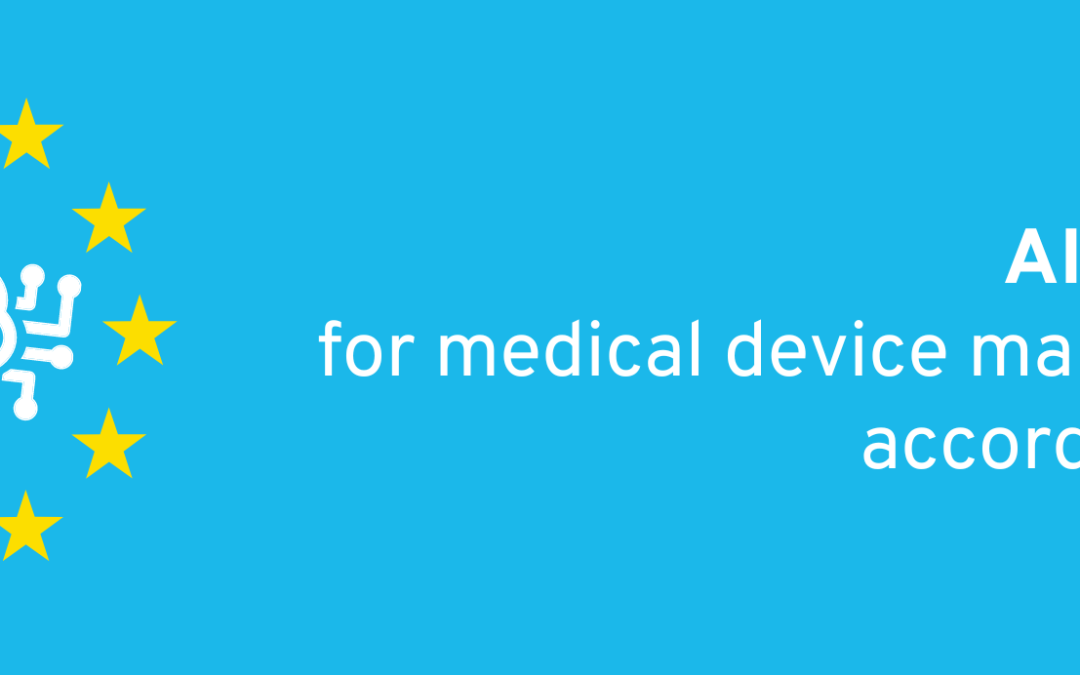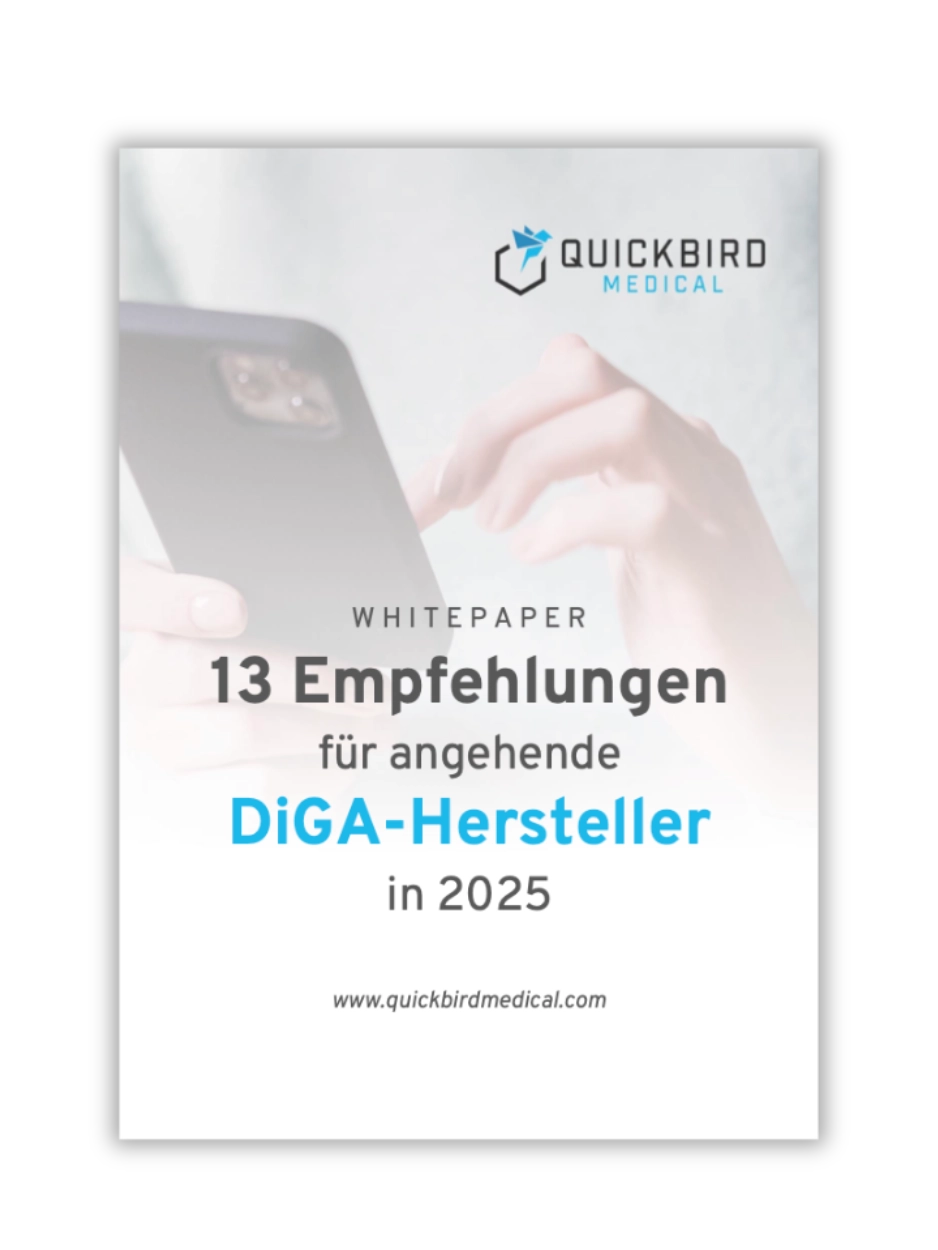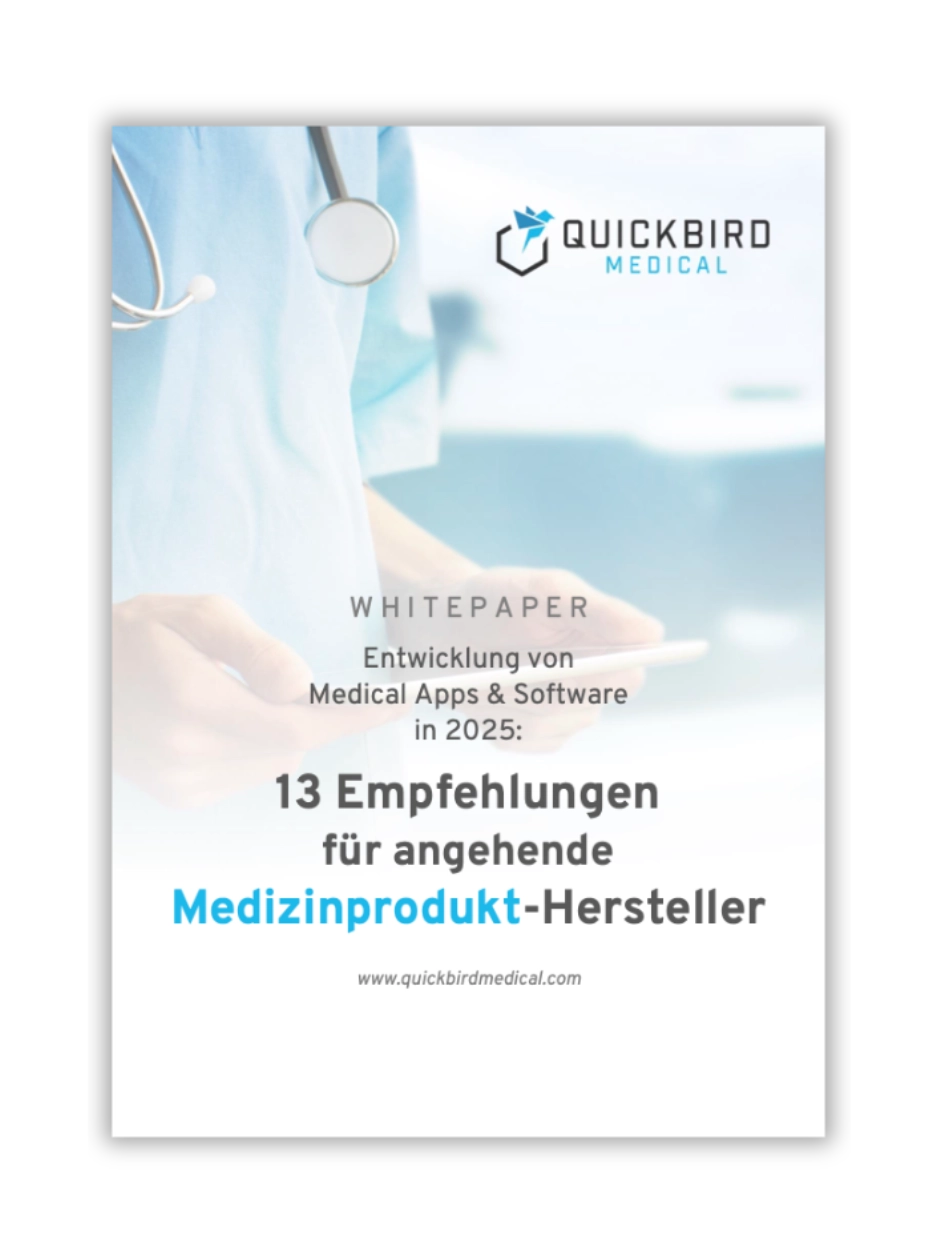The EU is now also regulating the use of artificial intelligence (AI) with the EU AI Act. This also affects manufacturers of software medical devices that integrate AI into their MDR medical devices. The AI Act is intended to ensure that AI systems are designed in a way that protects the security and fundamental rights of individuals.
- But is this AI regulation even relevant for my medical device?
- What additional requirements must medical device manufacturers in particular implement?
- And how do I manage to integrate these into my existing quality management system?
We answer these and other questions in this comprehensive guide to the EU AI Act. We focus entirely on the impact of the AI Regulation on MDR medical devices.
Contents of the guide to the AI Regulation
- 1. What is the AI Act? (Status 2025)
- 2. Is the AI Act relevant for my product?
- 3. The 3 product categories of the AI Act
- 4. Requirements for high-risk AI systems
- 5. How does the AI Act affect the approval of my medical device?
- 6. AI Act – Table of contents
- 7. Conclusion
1. What is the EU AI Act?
The AI Act is a regulation that governs the development and use of artificial intelligence (AI) in the EU. It is not limited to medical devices, but in principle addresses any product that falls under the definition of an AI system (see next chapter “Is the AI Act relevant for my product?”). The overarching goal of the AI Act is to protect the security and fundamental rights of individuals.
The complete regulation can be found on the website of the European Union.
Subscribe to our newsletter here to stay informed about relevant updates to the AI Act.
2. Is the AI Act relevant for my product?
The AI Act defines AI systems as follows:
For the purposes of this Regulation, ‘AI-system’ means a machine-based system that is designed to operate with varying degrees of autonomy, that may adapt after it has started operating, and that infers from given inputs, explicit or implicit objectives for producing outputs such as predictions, content, recommendations or decisions that may affect physical or virtual environments;
In summary, an AI system is therefore a software that derives from the received inputs how a certain output can be generated. In addition, the system can (but does not have to) work autonomously and continue to learn on an ongoing basis.
The bottom line is that it is not always completely clear which systems are exactly excluded, but since most products with AI fall under machine learning, they are very clearly covered by this definition.
3. The 3 product categories of the AI Act
Do all AI medical products have to fulfill the same requirements? The short answer is no.
Similar to the MDR, the EU AI Act also divides products into different classes:
- Prohibited AI practices
- High-risk AI systems
- Other AI systems (with low risk)
What class does my software medical device fall into? And what does that mean for me as a manufacturer?
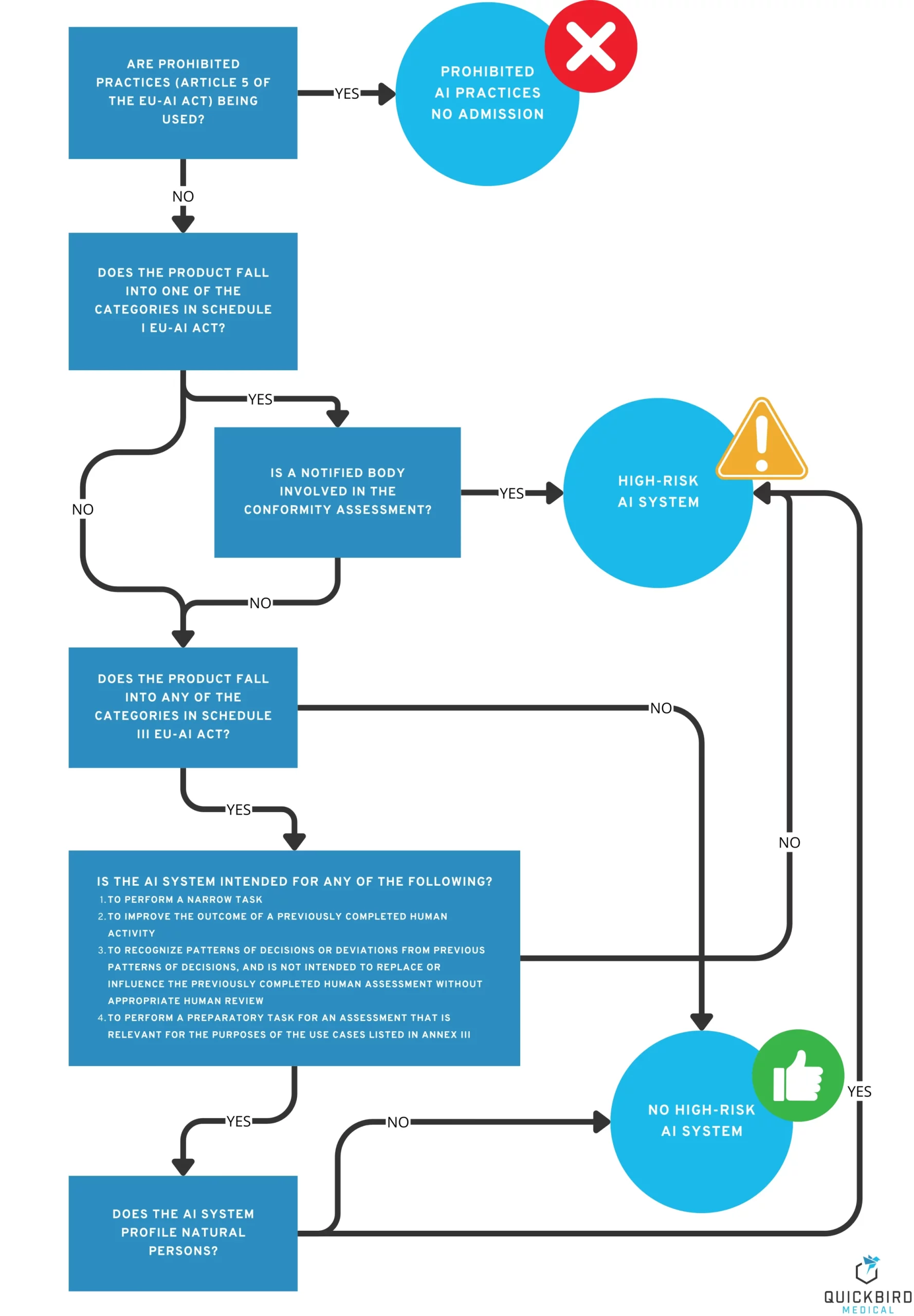
3.1 Product category 1: Prohibited AI practices
Reduced to the essentials, it can be said that, above all, practices that aim to harm people – by subliminally influencing them or exploiting certain weaknesses or vulnerabilities (e.g. disabilities, age) – are prohibited. Chapter 5 of the AI Regulation lists a number of other prohibited practices, but these are generally not relevant to medical devices.
Does my medical device fall into this category?
The goal of harming people usually contradicts the goals of a medical device, which is why you can generally assume that your AI does not fall into the category of “prohibited practices”. Nevertheless, you should take a close look at the criteria in Article 5 to be sure.
What requirements do I need to observe?
The product may not be placed on the market.
3.2 Product category 2: High-risk AI systems
This category includes products that pose a high risk to the health and safety or fundamental rights of natural persons.
Does my medical device fall into this category?
Particularly when it comes to the terms “health” and “safety”, the idea of “medical devices” is not far off, especially since the MDR also places a strong focus on the safety of the products it regulates.
If a notified body is involved in the conformity assessment procedure for your product (e.g. because it falls into risk class IIa or higher), your medical device is automatically a high-risk AI system according to the AI Regulation (see decision tree in the figure above). The notified body must then not only check the requirements of the MDR, but also those of the AI Act as part of the conformity assessment.
However, if a notified body is not involved in the approval of your product (e.g. because the product falls into risk class I according to the MDR, or it is not a medical device at all), you must first check Annex III of the AI Act. This contains a list of systems that are considered high-risk AI systems.
However, most medical devices will not be included in this list, which is why we assume that many MDR risk class I medical devices are not high-risk AI systems.
To find out whether your product is a high-risk AI system, read the following sections of the AI Regulation in this order:
- Article 6, paragraph 1 – Classification requirements for high-risk AI-systems
- Annex III – High-risk AI-systems referred to in Article 6 (2)
- Article 6, paragraph 3 – Exemptions for products in Annex III
What requirements do I need to observe?
If your product falls into the category of high-risk AI systems, the AI Regulation may have a significant impact on your organization and your medical device. This is because the contents of the EU AI Act specifically define requirements for the manufacturers of such systems and the systems themselves. We provide an overview of the requirements below in the chapter “Requirements for high-risk AI systems”.
3.3 Product category 3: Other AI systems (low risk)
All AI products that cannot be classified as either prohibited AI practices or high-risk AI systems fall into this category. Roughly speaking, these are systems that do not pose any significant risks to the safety and fundamental rights of individuals.
Does my medical device fall into this category?
If your product fulfills the following criteria, it probably falls into this category::
- It is a class I risk product according to MDR (no notified body is involved in the conformity assessment).
- It was ruled out that it is a high-risk AI system.
- It was ruled out that these were forbidden AI practices.handelt
What requirements do I need to observe?
Compared to high-risk AI systems, products in this category come off really well. Basically, there is only one requirement for such systems in the entire AI Act: transparency obligations. And these only apply to systems that interact with humans, generate media content, or are used for emotion recognition. Roughly speaking, manufacturers of such products must ensure that users know that they are dealing with AI and that the content generated is not real images, videos, etc. (e.g. deepfake).
AI systems in this category do not need to be registered in a separate database and do not require a declaration of conformity. So if your medical device falls into this category, the effort required to comply with the AI Act is likely to be manageable for you.
4. AI Regulation – Requirements for high-risk AI systems and their manufacturers
The exact requirements for high-risk AI systems and their manufacturers are specified in Chapter III, Section 2 and Section 3 of the AI Act. At this point, we assume that you already meet the requirements of the MDR. Thus, we will focus here on the points that go beyond the requirements of the MDR. Learn more about the MDR requirements for AI medical devices in this article: Approval & Certification of Software Medical Devices (MDR)
The AI Regulation defines the obligations of providers of high-risk AI systems as follows (Article 16).
You have to …
a) ensure that their high-risk AI-systems meet the requirements set out in Section 2;
(b) indicate their name, registered trade name or registered trade mark and their contact address on the high-risk AI system or, where that is not possible, on its packaging or in the documentation accompanying it;
(c) have a quality management system that complies with Article 17;
(d) keep the documentation referred to in Article 18;
(e) keep the logs automatically generated by their high-risk AI-systems in accordance with Article 19, if they are under their control;
(f) ensure that the high-risk AI-system is subject to the relevant conformity assessment procedure referred to in Article 43 before being placed on the market or put into service;
(g) draw up an EU declaration of conformity in accordance with Article 47;
(h) affix the CE marking to the high-risk AI system, or, where that is not possible, on its packaging or in the documentation accompanying it, to indicate conformity with this Regulation in accordance with Article 48;
(i) comply with the registration obligations referred to in Article 49(1);
(j) take the necessary corrective measures and provide the information required in accordance with Article 20;
k) upon reasoned request by a competent national authority, demonstrate that the high-risk AI system meets the requirements in Section 2;
l) ensure that the high-risk AI system meets the accessibility requirements in accordance with Directives (EU) 2016/2102 and (EU) 2019/882.
Don’t worry, we won’t leave you alone with this list. In the following, we would therefore like to shed some light on what this means for you as a manufacturer of an AI medical device. We will address the most important points that lead to an adaptation of your management system and/or medical device.
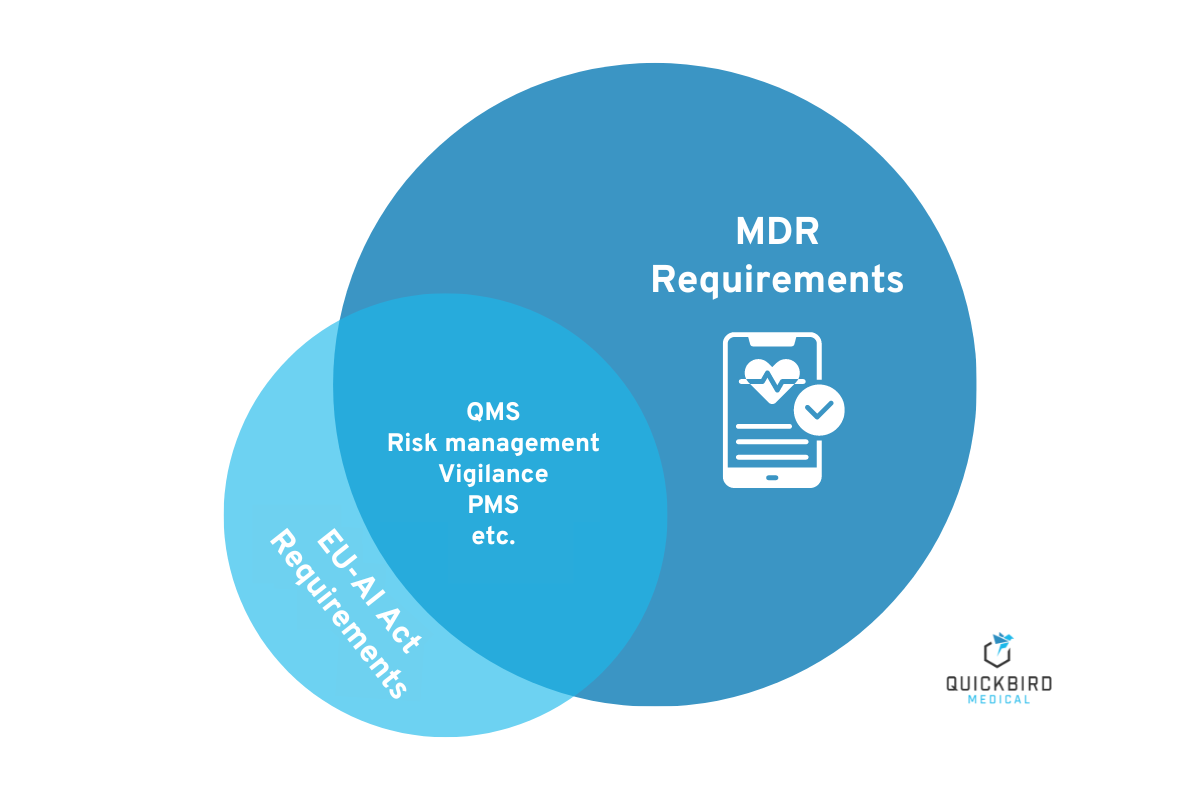
The requirements of the EU-AI Act and the MDR overlap in many respects.
4.1 AI Act – Requirements for your quality management system
The MDR already requires medical device manufacturers to establish a quality management system. In most cases, ISO 13485 and – when software is involved – IEC 62304 are implemented, among others. At first glance, it may appear that you have also fulfilled the requirements of the AI Act. On closer inspection, however, it becomes clear that this is only partially true. But don’t worry, the majority of your system can remain as it is. You just need to make a few adjustments and additions.
The requirements from Article 17 of the EU AI Act are listed in the table below. In addition to the exact requirements of the regulation, we have defined the specific measures for you that you must implement to ensure the corresponding conformity of your quality management system.
The quality management system must include at least the following aspects:
(Note: Our comments are not meant to be absolute truths, but merely to highlight any similarities and differences between the AI Act and your existing system. Therefore, for each point, check to see how you need to take action.)
| Wording from the AI Act | commentary on implementation |
|---|---|
| a) a concept for regulatory compliance, which includes compliance with the conformity assessment procedures and the procedures for managing changes to the high-risk AI system; | Since you, as a medical device manufacturer, already have a concept for compliance with the MDR, GDPR and other regulatory requirements, you should simply extend this to include the AI Act. |
| b) techniques, processes and systematic measures for the design, design control and design review of the high-risk AI system; | This point could already be implemented by ISO 13485 and IEC 62304. |
| c) Techniques, procedures and systematic measures for the development, quality control and quality assurance of the high-risk AI system; | this point should already be implemented by ISO 13485 and IEC 62304. |
| d) Investigation, testing and validation procedures to be carried out before, during and after the development of the high-risk AI system, and the frequency with which they are to be carried out. | This topic is also covered in ISO 13485, and as a medical device manufacturer, you already have appropriate processes in place. However, you should check whether your procedures are appropriate for the AI system. |
| e) the technical specifications and standards that will be applicable and, where the relevant harmonized standards will not be applied in full or they do not cover all of the relevant requirements set out in Section 2, the means to ensure that the high-risk AI-system complies with those requirements; |
However, harmonized standards for implementing the AI Act will be established by the European Commission over time. This will probably be similar to the MDR, whose harmonized standards are published in an implementing decision and are continuously being expanded. |
| f) systems and procedures for data management, including data extraction, data collection, data analysis, data labeling, data storage, data filtering, data interpretation, data aggregation, data retention and other operations performed on data in advance of and for the purpose of placing on the market or putting into service high-risk AI-systems; | These procedures will probably have to be newly established, as they are not explicitly required by the MDR or the associated standards. You can find out more about this in the “Data and data governance” section below. |
| (g) the risk management system referred to in Article 9; |
This point should be largely covered by the MDR (or ISO 14971). Check to what extent your risk management already meets the requirements of the AI Act (see following chapters). |
| h) the establishment, implementation and maintenance of a post-market surveillance system in accordance with Article 72; |
This point is already largely covered by the MDR (post-market surveillance). Check to what extent your post-market surveillance system already meets the requirements of the AI Act (see following chapters). |
| (i) the procedure for reporting a serious incident as referred to in Article 73; |
This point is largely covered by the MDR (vigilance). There is even a special regulation for medical devices. Since medical device manufacturers already have such a system in place, the AI Regulation merely requires that the new requirements be integrated into this system. You will need to assess the extent to which these requirements will result in changes to your system. It may well be that little or no effort is required here. |
| (j) the management of communication with national competent authorities, other relevant authorities, including authorities granting or facilitating access to data, notified bodies, other stakeholders, customers or other interested parties; | ISO 13485 already requires you to regulate communication with various stakeholders. So simply add any new authorities or actors to this list to achieve compliance with this point. This could become relevant, for example, if you want to use data from an AI real-world laboratory. |
| (k) systems and procedures for recording all relevant documentation and information; | You should have already implemented this point through your quality management system. The aim here is to establish processes that generate the necessary outputs (e.g. technical documentation). |
| l) Resource management, including measures with regard to security of supply; | You should have already implemented this point through your quality management system in accordance with ISO 13485. |
| m) an accountability framework that governs the responsibilities of management and other personnel with regard to all aspects listed in this paragraph. | You can transfer this responsibility to your PRRC according to MDR, or define a new role for it. |
4.1.1 Risk management
As a medical device manufacturer, you already have a risk management system in place and may be subject to various laws regarding risk management activities (e.g. MDR, GDPR).
However, the requirements for the risk management system are not the same in MDR and AI Act! Probably the most fundamental difference is that you not only have to consider risks in terms of safety, but also in terms of the fundamental rights of individuals. While this may be partially addressed by compliance with other regulations (e.g., GDPR), an AI system can violate not only physical integrity and personal data protection, but also other rights.
Be sure to take a look at the Charter of Fundamental Rights of the European Union.
In addition, high-risk AI systems must be regularly tested using appropriate procedures (this presumably applies above all to continuously learning systems, which can only be approved in exceptional cases under the MDR). This testing is also necessary to determine the most appropriate risk management measures.
The identified risks are reduced to the extent technically possible and to a justifiable degree.
4.1.2 Post-market surveillance system
The MDR already requires you to ensure the post-market surveillance of your medical device. This is also explicitly addressed in the AI Regulation. If you have already established such a system under the MDR, you must check whether it also fulfills the following requirement: the system must enable you to continuously assess the conformity of the product.
4.1.3 System for reporting serious incidents and malfunctions
Due to your already established vigilance system in accordance with the MDR, there is little to implement in this area. The AI Act even has a special rule for medical devices. As there is already an obligation to report safety-related incidents, you only need to expand your system to include the reporting of “breaches of the provisions of Union law on the protection of fundamental rights”.
4.1.4 Data and data governance
As a manufacturer, you are obliged to establish suitable processes that regulate the following:
- Conceptual decisions (e.g. choice of model type, definition of relevant features)
- Data collection (e.g. data sources)
- Data preparation processes (e.g. labeling, cleansing, aggregation)
- List of relevant assumptions (e.g. relationship between features, potential influencing factors)
- Prior assessment of the availability, quantity and suitability of the required data sets
- Investigation of possible distortions/bias and appropriate measures to detect, prevent and mitigate them
- Identification of possible data gaps, deficiencies and measures to rectify these
This chapter also contains specific requirements for your training, validation, and test data. You should integrate these requirements directly into your processes.
Tip: When creating these processes, also take into account the requirements for technical documentation in Annex IV and Article 11 of the AI Regulation. This will ensure that your procedures also generate the necessary outputs.
4.1.5 Retention requirements
If you comply with the MDR’s retention requirements, you probably also fulfill those of the AI Act. This defines that you must retain your documentation for a period of 10 years after the AI system has been placed on the market. According to Article 18 of the AI Regulation, this documentation includes the technical documentation, the quality management system, changes released by notified bodies and documents issued, as well as the declaration of conformity.
Protocols automatically generated by the product must be kept for 6 months.
4.2 AI Act – Requirements for technical documentation
“Technical documentation” is a term that you are probably already familiar with from the MDR. You have to create technical documentation for your medical device anyway. In fact, there are many parallels here too, and you will have already implemented most of the points by complying with the MDR. These include, for example, the product description, a declaration of conformity and the methods used in product development.
However, this does not apply in every case! In particular, software systems in software safety class A according to IEC 62304 may have some special features with regard to the technical documentation.
The AI Regulation requires you, for example, to document a system architecture and the definition of interfaces to other systems. This goes beyond the requirements of IEC 62304 for software systems in safety class A.
Tip: It is not possible to say in advance to what extent your technical documentation will need to be expanded. It is best to go through Annex IV of the AI Act and check for each point to what extent you have already implemented it in your current documentation. Ideally, you should then create any missing information in the course of the newly defined or adapted processes.
4.3 Product requirements
4.3.1 Recording and logs
High-risk AI systems are required to keep logs. This is therefore a clear technical requirement. As is often the case, these logs must be kept to an extent that is “adequate for the purpose”. Article 12 of the AI Regulation defines what this means. According to this article, the logs must, above all, record events that are relevant for the following:
(a) the identification of situations that could result in the high-risk AI-system posing a risk as referred to in Article 79(1) or in a significant change occurring;
b) facilitating post-market monitoring in accordance with Article 72; and
(c) the monitoring of the operation of high-risk AI systems in accordance with Article 26(5).
The core objective is to be able to monitor and trace situations that are associated with risks and damage as well as possible.
When implementing this logging, manufacturers must adhere to recognized standards and specifications (e.g. requirements of the BSI).
4.3.2 Accuracy, robustness and cybersecurity
High-risk AI-systems must be resilient to errors, faults or discrepancies that may occur within the system or the environment in which the system operates, in particular as a result of its interaction with natural persons or other systems. The robustness of high-risk AI-systems can be achieved through technical redundancy, which may include back-up or fault tolerance plans.
High-risk AI systems that continue to learn after being placed on the market (or put into operation) are to be developed in such a way that appropriate risk-mitigation measures are taken to address any potentially biased results.
High-risk AI systems must be resilient to attempts by unauthorized third parties to alter their use or performance by exploiting system vulnerabilities.
The technical solutions for ensuring the cybersecurity of high-risk AI systems must be appropriate to the respective circumstances and risks.
Technical solutions for dealing with AI-specific vulnerabilities include, where appropriate, measures to prevent and control attacks that attempt to manipulate the training data set (“data poisoning”), input data that is intended to trick the model into making mistakes (“adversarial examples”), or model deficiencies.
4.3.3 Transparency and provision of information for users
If you don’t yet have instructions for use for your medical device, you need them now at the latest. If you already have instructions for use, you will probably need to revise them. Even though some requirements are already covered by the MDR, the AI Act now also requires information on aspects such as cybersecurity and risks to fundamental rights. The degrees of accuracy and relevant accuracy indicators of the system must also be stated here.
So check your current instructions for use to see how you are already fulfilling the obligations of the AI Act, and then make the necessary adjustments.
4.3.4 Human supervision
The duty of human supervision is a mandatory risk control measure for high-risk AI systems. The system must be designed and developed in such a way that it can be effectively supervised by a human. Here, some parallels can be seen with the transparency requirements. Essentially, it must be possible for a user to understand what is happening in the product and what it is outputting. They must also be able to shut down the system or intervene in its operation.
The option for supervision can either be built directly into the software or handed over to the user. Roughly summarized, it must simply be possible to detect anomalies or misconduct and to stop the system in case of doubt.
4.3.5 CE marking
Your medical device already has a CE marking if you have approved it in compliance with the MDR. You just need to reference the appropriate regulation so that users can see that your product has been developed in accordance with both regulations (MDR and AI Act).
4.3.6 Registration of the product
Similar to EUDAMED for medical devices, there will also be an EU database for high-risk AI systems in the future, in which your product must be registered. However, at the moment such a database does not yet exist (as of 31.01.2025).
5. How does the AI Act affect the approval of my medical device?
The risk class of your medical device according to MDR affects the applicability of the AI Act. You can find out how to determine the risk class according to MDR in our guide to classifying software medical devices.
5.1 Risk class I
When it comes to the approval of products in risk class I according to the MDR, the AI Act does not change anything (except for the requirements of Chapter 3.3) – as long as the product does not constitute a high-risk AI system.
However, should this be the case, you will need a notified body to assess conformity with the AI Regulation in the future.
Be sure to keep this in mind when planning to implement a risk class I product, as it can significantly delay market entry.
5.2 Risk class IIa or higher
Products in risk class IIa are automatically high-risk AI systems under the AI Act. This means that some additional requirements have to be implemented, which have already been explained above in the article.
When it comes to approval (in particular the conformity assessment), you must make absolutely sure in future that your notified body is also accredited under the AI Regulation. In the course of the conformity assessment, this body must then check not only conformity with the MDR, but also with the AI Act. There are not two different tests. Only if the product is compliant with both regulations may it bear the CE symbol.
So, get in touch with your notified body as soon as possible to clarify whether such an accreditation for the AI Regulation is planned. If not, you should consider switching to another notified body.
6. Conclusion
The AI Act differs from the MDR first and foremost in its objective. While the MDR is primarily aimed at ensuring the safety and functionality of medical devices, the AI Regulation also includes the protection of the fundamental rights of individuals.
In principle, it can be said that MDR medical devices, in particular, will face many new requirements. These are automatically assigned to the category of “high-risk AI systems” in accordance with the AI Act. However, medical devices in risk class I may also fall into this category in individual cases.
For products that are not high-risk AI systems and do not fall under the “prohibited practices”, the AI Regulation brings few changes.
Manufacturers of high-risk AI medical devices must make adjustments to a number of areas in order to comply with the requirements of the AI Act. In addition to the requirements of the AI Act, you must, of course, also observe the requirements of the MDR that are relevant to artificial intelligence.
Do you need support with the development of a medical AI system?
We develop medical AI systems for companies in the healthcare sector on a contract basis.
Our AI services:
– Technical review of medical AI systems
– Development of new machine learning models in the healthcare sector
– Individual advice on regulatory compliance for your planned AI-based product
We help you to implement the extensive requirements of the MDR and the AI Act and develop a successful product.


